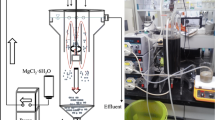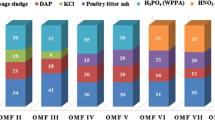Abstract
Leachates generated in methanogenic landfills contain high strength of ammonium nitrogen which removal is hard to be accomplished by means of conventional techniques. The chemical precipitation of struvite, which is a mineral that could be reused as a slow-release fertilizer, is an effective process in the removal and recovery of NH4 amount of high-concentrated wastewaters. In this paper, a struvite precipitation process using unconventional reagents is proposed for a sustainable recovery of nitrogen content. In particular, seawater bittern, a by-product of marine salt manufacturing, and bone meal, a by-product of the thermal treatment of meat waste, have been used as low-cost sources of magnesium and phosphorus, respectively. The process enables the removal of more than 98 % ammonia load, the recovery about 99 and 95 % of phosphorus and magnesium, respectively, and the production of a precipitate containing struvite crystals. Heavy metals concentrations of produced precipitate were below the threshold values specified by the EC Directive for use of sewage sludges as fertilizers. Specific agronomic tests were conducted to investigate the fertilizing value of precipitate recovered from landfill leachate. The fertilizing effect of struvite deposit in cultivating Spinacia oleracea was compared with that of vegetable soil and commercial fertilizer. The growth of selected vegetable in the pots with struvite precipitate resulted significantly greater in both than those in the control pots and in the pots with the complex fertilizer. Furthermore, the struvite application as fertilizer did not result in more heavy metals in the vegetables respect those from soil and model fertilizer.




Similar content being viewed by others
References
APHA (1998) Standard methods for the examination of water and wastewater, 20th edn. American Public Health Association and Water Environment Federation, Washington DC, USA
Çelen I, Türker M (2001) Recovery of ammonia as struvite from anaerobic digester effluents. Environ Technol 22:1263–1272
Chimenos JM, Fernández AI, Villalba G, Segarra M, Urruticoechea A, Artazab B, Espiella F (2003) Removal of ammonium and phosphates from wastewater resulting from the process of cochineal extraction using MgO-containing by-product. Water Res 37:1601–1607
Council of the European Communities (1986) Directive 86/278/EEC, Use of sewage sludge in agriculture. Journal of the European Union, Brussels, BE
Coutand M, Cyr M, Deydier E, Guilet R, Clastres P (2008) Characteristics of industrial and laboratory meat and bone meal ashes and their potential applications. J Hazard Mater 150:522–532
De Rosa S, Siciliano A (2010) A catalytic oxidation process of olive oil mill wastewaters using hydrogen peroxide and copper. Desal and Water Treat 23:187–193
Deydier E, Guilet R, Sarda S, Sharrock P (2005) Physical and chemical characterisation of crude meat and bone meal combustion residue: “waste or raw material?”. J Hazard Mater B 121:141–148
Di Iaconi C, Pagano M, Ramadori R, Lopez A (2010) Nitrogen recovery from a stabilized municipal landfill leachate. Bioresour Technol 101:1732–1736
El Diwani G, El Rafie S, El Ibiari NN, El-Aila HI (2007) Recovery of ammonia nitrogen from industrial wastewater treatment as struvite slow releasing fertilizer. Desalination 214:200–214
European Commission (2011) Commission Regulation (EU) N. 1258/2011, Amending Regulation (EC) No 1881/2006 as regards maximum levels for nitrates in foodstuffs. Journal of the European Union, Brussels, BE
Fattah KP, Sabrina N, Mavinic DS, Koch FA (2008) Reducing operating costs for struvite formation with a carbon dioxide stripper. Water Sci Technol 58(4):957–962
Gunay A, Karadag D, Tosun I, Ozturk M (2008) Use of magnesit as a magnesium source for ammonium removal from leachate. J Hazard Mater 156:619–623
He S, Zhang Y, Yang M, Du W, Harada H (2007) Repeated use of MAP decomposition residues for the removal of high ammonium concentration from landfill leachate. Chemosphere 66:2233–2238
Huang H, Mavinic DS, Lo KV, Koch FA (2006) Production and basic morphology of struvite crystals from a pilot-scale crystallization process. Environ Technol 27:233–245
Huang H, Xu C, Zhang W (2011) Removal of nutrients from piggery wastewater using struvite precipitation and pyrogenation technology. Bioresour Technol 102:2523–2528
Iqbal M, Bhuiyan H, Mavinic DS (2008) Assessing struvite precipitation in a pilot-scale fluidized bed crystallizer. Environ Technol 29:1157–1167
JCPDS (1988) International centre for diffractogram data. Search manual and data cards. Park lane, Swarthmore, USA
Kabdaşli I, Şafak A, Tünay O (2008) Bench-scale evaluation of treatment schemes incorporating struvite precipitation for young landfill leachate. Waste Manag 28:2386–2392
Kabdaşli I, Tünay O, Özcan P (2009) Application of struvite precipitation coupled with biological treatment to slaughterhouse wastewaters. Environ Technol 30:1095–1101
Karabegovic L, Uldal M, Werker A, Morgan-Sagastume F (2013) Phosphorus recovery potential from a waste stream with high organic and nutrient contents via struvite precipitation. Environ Technol 34:871–883
Kim D, Ryu HD, Kim MS, Kim J, Lee SI (2007) Enhancing struvite precipitation potential for ammonia nitrogen removal in municipal landfill leachate. J Hazard Mater 146:81–85
Korchef A, Saidou H, Ben Amor M (2011) Phosphate recovery through struvite precipitation by CO2 removal: effect of magnesium, phosphate and ammonium concentrations. J Hazard Mater 186:602–613
Kumar B, Chakrabortty S, Pal P (2015) Membrane-integrated physico-chemical treatment of coke-oven wastewater: transport modelling and economic evaluation. Environ Sci Pollut Res 22:6010–6023
Kurniawan TA, W-h L, Chan GYS (2006) Physico-chemical treatments for removal of recalcitrant contaminants from landfill leachate. J Hazard Mater B129:80–100
Latifian M, Liu J, Mattiasson B (2012) Struvite-based fertilizer and its physical and chemical properties. Environ Technol 33:2691–2697
Le Corre KS, Valsami-Jones E, Hobbs P, Parsons SA (2005) Impact of calcium on struvite crystal size, shape and purity. J Cryst Growth 283:514–522
Lee SI, Weon SY, Lee CW, Koopman B (2003) Removal of nitrogen and phosphate from wastewater by addition of bittern. Chemosphere 51:265–271
Li XZ, Zhao QL (2003) Recovery of ammonium-nitrogen from landfill leachate as a multi-nutrient fertilizer. Ecolog Eng 20:171–181
Marti N, Pastor L, Bouzas A, Ferrer J, Seco A (2010) Phosphorus recovery by struvite crystallization in WWTPs: influence of the sludge treatment line operation. Water Res 44:2371–2379
Pastor L, Mangin D, Ferrer J, Seco A (2010) Struvite formation from the supernatants of an anaerobic digestion pilot plant. Bioresour Technol 101:118–125
Quintana M, Colmenarejo MF, Barrera J, García G, García E, Bustos A (2004) Use of a byproduct of magnesium oxide production to precipitate phosphorus and nitrogen as struvite from wastewater treatment liquors. J Agric Food Chem 52:294–299
Ryu H-D, Lim C-S, Kang M-K, Lee S-I (2012) Evaluation of struvite obtained from semiconductor wastewater as a fertilizer in cultivating Chinese cabbage. J Hazard Mater 221–222:248–255
Saidou H, Moussa B, Ben AM (2009) Influence of airflow rate and substrate nature on heterogeneous struvite precipitation. Environ Technol 30:75–83
Siciliano A, De Rosa S (2014) Recovery of ammonia in digestates of calf manure through a struvite precipitation process using unconventional reagents. Environ Technol 35:841–850
Siciliano A, De Rosa S (2015) Experimental formulation of a kinetic model describing the nitrification process in biological aerated filters filled with plastic elements. Environ Technol 36:293–301
Siciliano A, Ruggiero C, De Rosa S (2013) A new integrated treatment for the reduction of organic and nitrogen loads in methanogenic landfill leachates. Process Saf Environ Prot 91:311–320
Siciliano A, Stillitano MA, De Rosa S (2015) Increase of the anaerobic biodegradability of olive mill wastewaters through a pre-treatment with hydrogen peroxide in alkaline conditions. Desal and Water Treat 55:1735–1746
Siciliano A, Stillitano MA, De Rosa S (2016) Biogas production from wet olive mill wastes pretreated with hydrogen peroxide in alkaline conditions. Renew Ener 85:903–916
Uludag-Demirer S, Demirer GN, Chen S (2005) Ammonia removal from anaerobically digested dairy manure by struvite precipitation. Process Biochem 40:3667–3674
Uysal A, Yilmazel YD, Demirer GN (2010) The determination of fertilizer quality of the formed struvite from effluent of a sewage sludge anaerobic digester. J Hazard Mater 181:248–254
Uysal A, Demir S, Sayilgan E, Eraslan F, Kucukyumuk Z (2014) Optimization of struvite fertilizer formation from baker’s yeast wastewater: growth and nutrition of maize and tomato plants. Environ Sci Pollut Res 21:3264–3274
Wu Y, Zhou S (2012) Improving the prediction of ammonium nitrogen removal through struvite precipitation. Environ Sci Pollut Res 19:347–360
Yetilmezsoy K, Sapci-Zengin Z (2009) Recovery of ammonium nitrogen from the effluent of UASB treating poultry manure wastewater by MAP precipitation as a slow release fertilizer. J Hazard Mater 166:260–269
Acknowledgments
The author thanks Eng. Camilo Haro Barroso and Eng. Maria Assuntina Stillitano for the analytical support.
Author information
Authors and Affiliations
Corresponding author
Additional information
Responsible editor: Zhihong Xu
Rights and permissions
About this article
Cite this article
Siciliano, A. Assessment of fertilizer potential of the struvite produced from the treatment of methanogenic landfill leachate using low-cost reagents. Environ Sci Pollut Res 23, 5949–5959 (2016). https://doi.org/10.1007/s11356-015-5846-z
Received:
Accepted:
Published:
Issue Date:
DOI: https://doi.org/10.1007/s11356-015-5846-z




